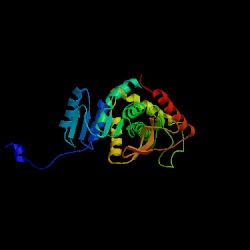| pyruvate will be completely oxidized to CO2 and H2O using the citric acid cycle and the elctron transport cycle. This pathway yeilds a large number of ATP that the cell can then use. However, if a cell lacks the ability to oxidize pyruvate (due to a lack of oxygen or problems with either the TCA cycle or electron transport system) then it is restricted to the glycolytic pathway for it production of ATP. If sufficient glucose is present, pyruvate will be disposed of, so long as ADP, NAD+, and Pi are present. All cells have plenty of ADP and Pi because these are the hydrolysis products of ATP. However, the amounts of NAD+ are limited, and therefore NADH must be oxidized back to NAD+.
Why must NADH be oxidized back to NAD+? NAD+ is required for glyceraldehyde-3-phospate to be oxidized to 1,3-bisphosphoglycerate during glycolysis. Without it glycolysis could not continue and there would be no further production of ATP. It is in the oxidation of NADH to NAD+ that lactate dehydrogenase(LDH) plays an important role. LDH catalyzes the following reaction
Pyruvate + NADH + H+ <----> Lactate + NAD+
The lactate then diffuses out of the cell and the NAD+ is used to continue glycolysis.It is in this manner that the cell continues to produce energy under anerobic conditions. The utility of anerobic glycolysis to a muscle cell when it needs large amounts of energy stems from the fact that the rate of ATP production from glycolysis is 100 times faster than from oxidative phosphorylation. During exertion muscle cells do not need to energize anabolic reaction pathways. The requirement is to generate the maximum amount of ATP for muscle contraction, in the shortest time possible. This is why muscle cells derive almost all of their energy from glycolysis during exertion. As soon as the oxidative phosphorylation pathway, and oxygen become available the reverse of the reaction will occur. LDH will take lactate and NAD+ and convert them to pyruvate, NADH, and H+. The pyruvate can then be completely oxidized to CO2 and H2O, yeilding a large number of ATP.
|
